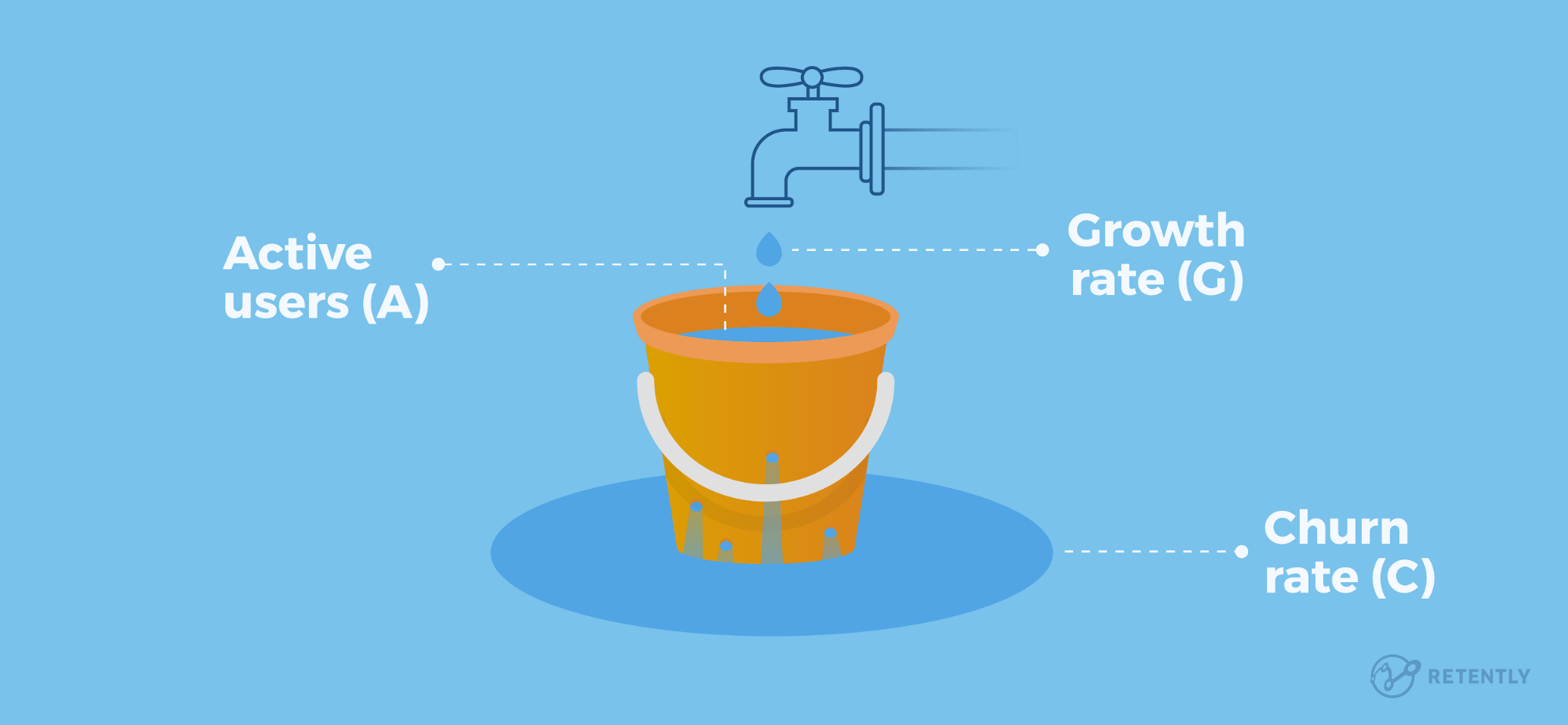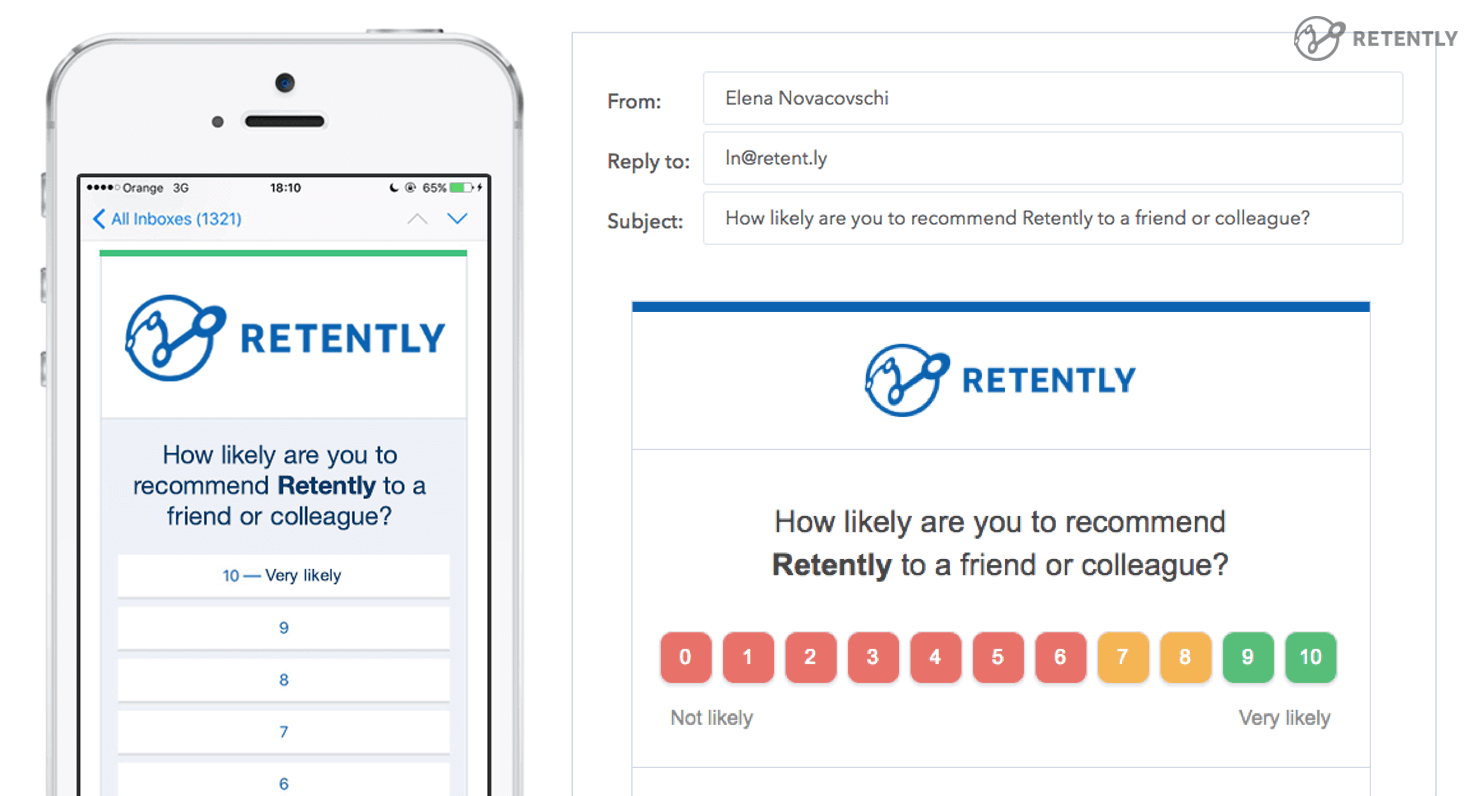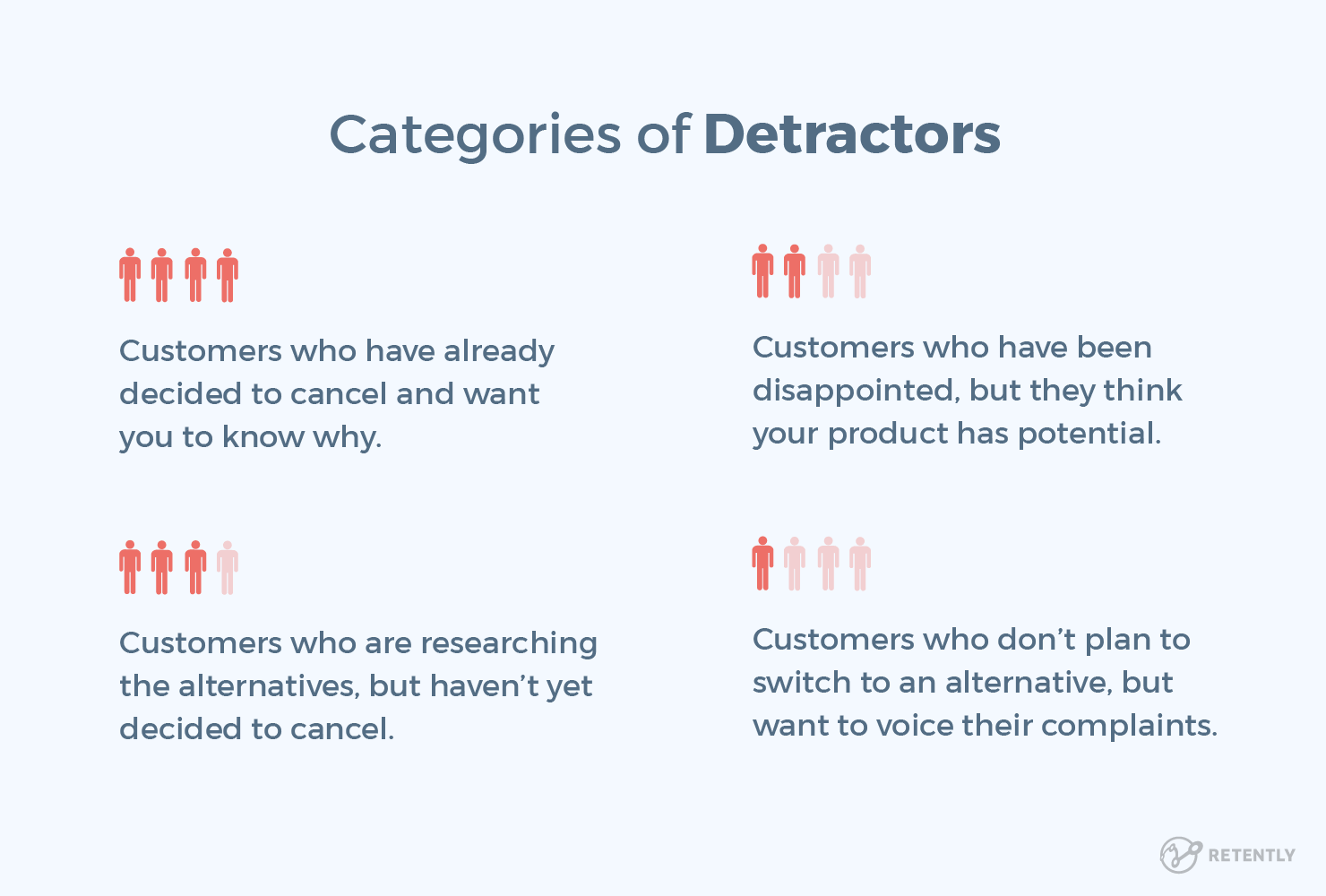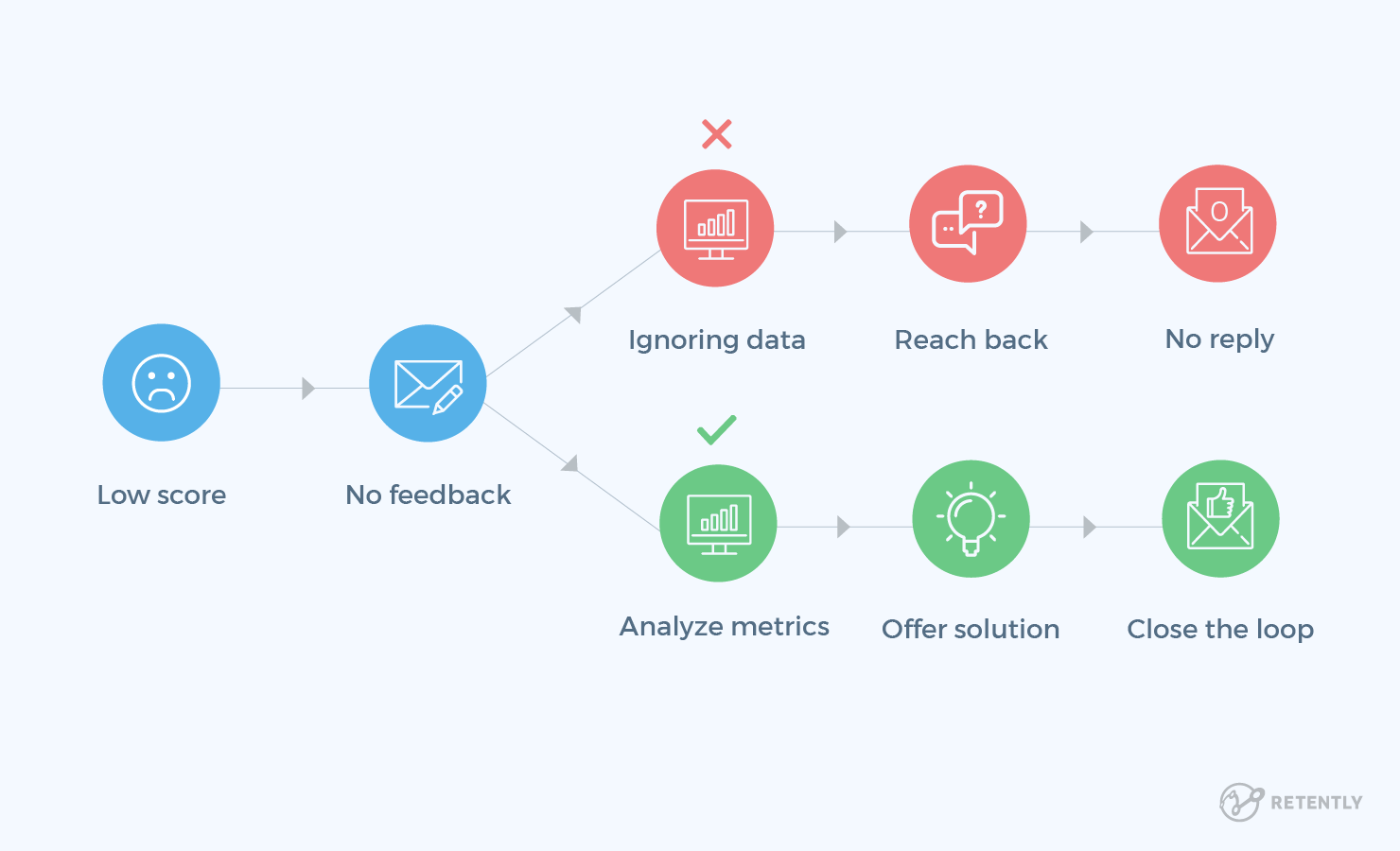Detractors are kind of a “taboo” topic in the business world – nobody really likes talking or thinking about upset customers.
But those customers are actually vital for business development and this quote should sum up just how important they really are:
“The brand is no longer what we tell the customer it is – it is what the customers tell each other it is.”- Scott Cook
True, most unhappy customers decide to never use the service they didn’t like, or even worse, share their disappointment with their friends.
That shows why you can’t ignore Detractors, but there’s more. Even though negative feedback might seem like a terrible thing, customers that express their dissatisfaction are creating an opportunity for you to improve their experience.
But how do you actually do that?
Well, if you want to truly understand Detractors, and learn how to appease them, check out this article.
What Is a Detractor?
Generally speaking, you define Detractors as someone who is unhappy with your brand, product or service; someone who finds fault with everything you say or do.
In other words – a critic.
In business, this term is used when referred to a customer segment in the Net Promoter Score® framework. Detractors are the survey respondents that score you from 0 to 6 on the NPS® scale. They are unsatisfied customers who will recommend against your company.
But as a more standard Detractors definition, you can just think of them as dissatisfied customers.
How to Identify Detractors
There are several customer satisfaction metrics that you can use to identify your Detractors, the top two being – Customer Satisfaction Surveys (CSAT) and Net Promoter Score (NPS) surveys.
To understand the difference between these methodologies, consider the following analogy:
Let’s assume that your company is a bucket holding a “pool” of customers.
The water flowing from the above tap is the newly acquired customers, while the holes in the bucket are potential bottlenecks in customer experiences that push the water out.

The rate at which the water flows from the tap would be your company’s growth rate (G), while the total outflow of water through the holes would be your churn rate (C).
Ideally, you would want to reduce your churn rate and increase the growth rate, so that you could serve the maximum number of customers and build up revenue.
CSAT helps you assess the number of holes in your bucket, and provides actionable insights for solving them. It’s measured by asking how customers would rate a recent business experience on a scale of 1 to 5 (there are also variations with a scale of 1-3 or 1-7).
Net Promoter Score, on the other hand, tracks the overall customer experience. It’s measured by asking the question:
“On a scale of 0-10, how likely are you to recommend [company] to a friend or colleague?”

While CSAT measures customer satisfaction for every activity, NPS data helps you assess the potential growth rate of your company and provides open-ended actionable feedback to bring down the churn.
To explain it with the pool analogy, CSAT aims to just fill up the holes (C), but they don’t give you solid insights into the projected growth trajectory (G).
NPS can be used to discover leaks that you didn’t even know existed. It’s focused on the overall customer experience instead of a specific interaction.
It also offers much wider coverage. While CSAT surveys mostly reach active users (who are already engaged with your product), NPS surveys can be sent to users who are about to churn or newly acquired users (who have not yet used the service).
For any conventional business, CSAT acts as a lagging indicator of short-term customer happiness (satisfactory transactional experiences), while NPS acts as the leading indicator of long-term customer happiness (great product experiences).
Since you are at a higher risk of losing non-engaged and dissatisfied customers than active users, NPS proves to be a much better metric for identifying core issues and reaching customers before they switch to a competitor.
That, however, does not mean that CSAT surveys are inferior to NPS.
Often, feedback captured from CSAT surveys can be instrumental in root cause analysis and improving customer experiences. These surveys can be used in conjunction with NPS surveys to narrow down short-term problems, weigh their importance, and take corrective action.
How Detractors Can Ruin Your Business?
It can be easy to ignore Detractors if they’re not a very large percentage of your whole customer base. You can make money off of your loyal clients, right?
Not exactly. If you actually do that, you leave your business open to serious risks since Detractors can damage it.
Here’s how:
Detractors Bring Your Sales & Profits Down
It’s not hard to see how – upset customers simply won’t have a reason to keep doing business with you. In fact, according to data, poor service costs businesses an average of $41 billion each year – and that’s only in the US!
Let’s take a closer look at the facts.
To start with, it’s well known that around 41% of consumers will spend less money on a service if they have a bad experience with it.
What’s more, 51% of B2B customers will avoid your brand if they have a poor customer service experience for up to two years.
Your business will also lose money because you’ll need to find new customers to take the place of the Detractors you lost. Acquiring new customers is more expensive than retaining existing ones – five times more, to be precise.
On top of the money wasted on ads and lead generation, you’ll lose valuable time and manpower which could be redirected to the benefit of your existing customers.
Moreover, research showcase that the success rate of selling to a new customer is only between 5% and 20%. Compare that to the rate for existing customers which is between 60% – 70%.
Oh, and get this – only one in 26 unhappy customers is going to complain. The other 25 will simply churn. So, you might not even realize how much money you lose until it’s too late.
Detractors Harm Your Brand’s Image
In times where negative word of mouth can have damaging effects on your business, ignoring such customers would be a big mistake. Thanks to the power of social media, people can now easily gather and share information on their experience with your brand.
And social media is exactly where a large number of customers go to complain when they have a poor experience with a brand.
What’s more, 70% of consumers specifically call out brands on social media to make other people aware of potential issues.
Safe to say, that’s not going to do your brand’s image any favors. Potential leads will be scared off when they associate your company’s name and imagery with those social media posts and angry reviews from unhappy customers.
Also, consider this – a dissatisfied customer will tell anywhere from 9 to 15 people about the bad experiences they had with your brand. Even worse – approximately 13% of them go the extra mile and notify 20 people about this.
Lastly, in very extreme scenarios, customers might be so upset to go as far as informing the media about their experience. Granted, only 5% do that for now, but it’s not exactly a risk you can afford to ignore.
It’s the kind of thing big companies like Time Warner Cable and Comcast ignored for years, that place them at the bottom of the customer satisfaction benchmarks.
Detractors Help Your Competition
“Although your customers won’t love you if you give bad service, your competitors will.”
That quote from Lauren Freedman (President of the e-tailing group, a popular eCommerce consultancy) pretty much sums it all up.
Quick – what’s the first thing a Detractor is going to do once they abandon your brand?
Find an alternative to your service, of course. And that’s where your competitors come into play – they’re just waiting to snatch up your customers.
That’s no speculation – 8 in 10 customers say they have no problem switching to a competitor if they receive poor customer service.
And pretty much anything can trigger that.
In fact, 74% of consumers consider switching to a competitor if the checkout process is difficult, while 50% of them will gladly do it if you don’t anticipate their needs. Also, if your customers feel like they are underappreciated, nearly 40% of them will switch companies.
So the more Detractors you have, and the more you ignore them, the easier you make it for your competitors to take the lead on the market.
How Much Time Do You Have to Stop a Detractor from Churning?
The answer to this question depends on a number of factors, from your responsiveness to your ability to connect with the customer, solve their issues and improve their experience.
There’s no “industry standard” time that you can use to work out how long you have until a Detractor leaves. Most Detractors, however, fit into one of the below categories:
- They’ve already decided to cancel and want you to know why;
- They are frustrated and actively researching and considering alternatives, but haven’t decided to cancel yet;
- Certain aspects of your product or a single interaction have disappointed them, but they still think your product or service has potential and want to help you improve it;
- They use your product out of necessity and aren’t actively considering switching to an alternative, but want to voice their complaints and criticism.
Although not all Detractors fit into these categories, you can use them to segment many of your customers based on their feedback. Most of the time, customers in the first category — Detractors that have already decided to cancel — will leave the soonest.
Retaining these customers can be a serious challenge — one that simply can not be taken up by most brands. Once a customer has made up their mind to cancel, they’re already out the door.
Detractors that fit into the other three categories, however, usually won’t rush to cancel.

How to turn Detractors into Promoters?
Retaining a customer who’s already next to the door is a real challenge. We’ll outline several actionable strategies we tested out and found to work very well:
1. Encourage Feedback & Make It Simple to Get in Touch
The truth is that you have fewer fully satisfied customers than you might think. If you don’t hear a complaint, it doesn’t mean that everything is perfect. And if you don’t see it, there’s little you can do to prevent any future occurrences.
Many customers who feel ignored simply stop doing business with you or switch to your competitor without even giving you the opportunity to improve.
Bearing this in mind, you should make it simpler for the customer to get in touch with you. If they run into another barrier of not being able to voice their complaint, that will only anger them more.
Don’t let customer surveys be the only way they can reach you. Be available to provide customer support on the channel they prefer using. Be it your website, mobile app, or social media – they should be able to provide feedback without having to complete numerous forms.
Also, don’t wait until customers come to you. Be proactive in reaching out to them and asking for feedback. They will give you the opportunity to fix small problems on the initial stage before they escalate into bigger issues.
Just make sure you give off the feeling that you want their feedback and need their suggestions. Customers are setting time aside out of their busy days to give valuable feedback. So, if you make them feel like you’re just collecting data for the show, they will not be willing to collaborate.
Around 73% of buyers say that valuing their time is one of the best ways a company can offer them great service. And we already discussed how upset customers will quickly switch to a competitor if they feel like you don’t appreciate them enough.
So we’re not just speculating.
In addition, put your contact information prominently across your website or email. People want to know that they can reach you.
Oh, and train your employees to be amiable even if the feedback is negative, or the customer is very angry. If they talk back or try to shift the blame on the client, it will only escalate the hostilities, making things worse.
What they actually need to do in such a situation is to listen, ask questions, apologize, and be polite. Detractors might actually calm down when they see that your reps are emphatic and taking their frustrations and pain points seriously.
2. Provide Swift Responses
If a Detractor is in a “pulling my hair” state, responding as soon as possible should become your first priority. One unsolved issue in due time can escalate to several brand-damaging comments since 40% of business buyers get frustrated the most because of slow response times.
Replying to a customer in less than an hour rather than 48 hours can make a huge difference – it demonstrates that you are genuinely concerned about their satisfaction and that your business puts client interests first. Also, a timely response can significantly minimize the chances of possible damage to your reputation.
After all, when it comes to customer service, 90% of consumers want an “immediate” response. And 60% rate “immediate” as ten minutes or less!
Sure, that mostly sounds like B2C buyers, but get this – 80% of B2B customers also expect responses in real-time. In fact, 67% of them actually want a response via email within one hour. 15% of them expect to get an immediate answer.
Automation can improve your efficiency by allowing you to make the most of your time. While some companies might be hesitant to use automation due to its impersonal nature, when properly implemented, automated responses can be a great way of interacting with customers.
But don’t get carried away by that. You can’t just automate replies – you also need to personalize them. If the already upset Detractors see a generic reply, there’s a good chance they’ll simply ignore it assuming you didn’t even bother listening to their problems.
Plus, personalization is more important than ever nowadays. Luckily, today’s automation tools can personalize your responses in many ways that will help you take care of far more customers than you possibly could if you were using the old-fashioned, manual approach.
Let’s say you want to send a personalized email to those Detractors who haven’t specified why they gave you a low score.
What you can do is set up a rule that will trigger an email reply to those contacts that gave you a rating of zero to six points on the NPS scale. Personalize your email by including their name, acknowledgment of their feelings, a question to find out what went wrong and a sweet thank you for closure.
3. Listen and Show Empathy
About 79% of consumers want human-driven service nowadays. They just don’t like the idea of dealing with a chatbot or self-service options.
It’s not hard to see why. Customers often understand that you are following the script. And it might make them feel like “I’m just another problem on their list”.
Try to make an emotional connection with your customers and give them a sense that you are in a conversation with them. Speak to them in a friendly and engaging tone. Appear eager to solve their concerns. The occasional emoticon might actually mellow down even the most frustrated customers. Typically, customers prefer a casual tone, and reps acting like a human – not a machine.
When customers reach out to you, they want to be heard and to feel like you are on their side. Apologizing and relating with simple phrases like “I’d be upset too if that happened to me,” can do the trick. Overall, the tonality should express that they as a customer matter to you and that you both are facing this challenge together.
Listening is another crucial element of showing that you care. You should get a sense of how your customers feel by paying attention to the tone of voice and punctuation – are they stressed, angry or frustrated? Knowing this information can help you choose the right approach.
Here’s a quote that best illustrates why actively engaging with upset customers is an asset:
“When customers share their story, they’re not just sharing pain points. They’re actually teaching you how to make your product, service, and business better.”
4. Don’t Overpromise and Underdeliver
Sometimes, it can take time to implement the suggestions or feedback received from your customers, so it is important to inform them that their feedback is being considered and used to improve.
And if you can’t fix the issue, make sure to explain why. Be honest with them. Honest business practices motivate customers. That means employees will work harder and consumers will buy more of your product.
Never make promises you can’t respect. It’s better to come clean and admit what limitations you’re dealing with than to overpromise and underdeliver. If you do that, you’ll lose their trust for good – not to mention it’ll make your brand look bad.
And whatever you do, don’t tell Detractors there’s nothing you can do to help them. Instead, focus on what you can do for them – even if that means issuing a refund. Always make sure that the interaction you had with your customers will leave behind a good memory.
5. Set Up a Prioritization System
This is one of the most efficient ways to optimize your support team’s workflow. Asking for and collecting feedback is a good start, but if your support reps get flooded with tickets, and don’t know which ones to handle first, you’ll just end up losing the Detractors for good.
You could use a FIFO system (First In First Out), which pretty much means your support teams help customers in the order they sent the inquiries in.
However, that can be an issue when dealing with Detractors. After all, should your support team handle a lead’s question about your product just because they sent in the ticket first, or should they focus on a Detractor who is having trouble with the product instead?
So what approach works better then?
It’s best to use customer support software that allows you to use automation to directly assign priority levels to customer tickets based on their severity (which you do by creating rules). Also, one should look into applying the escalation rules, that will redirect it to other staff in the operational hierarchy.
6. Close the Feedback Loop
Responding to Detractors fast, doing that in a calm and polite manner, acknowledging their frustrations, and properly prioritizing issues is very important.
But that alone won’t be enough to fully turn Detractors into Promoters.
To do that, you also need to provide a solution – basically, act on the received feedback. Start by sharing it across departments, and discussing recurring problems with stakeholders.
And don’t be afraid to collaborate with Detractors throughout the whole process if they’re willing – they can provide valuable insights, and you show them how much you value their opinions.
Once you have a clear idea of which issues should be handled first, share the key takeaways with your team.
Finally, you also have to follow up with Detractors to let them know what actions were taken following their feedback, and what the results were. That’s the only way you will manage to close the customer feedback loop, which is essential to offering a better customer experience.
7. Learn From Your Mistakes
Your most unhappy customers are your greatest source of learning. If all you want is for your NPS score to be high – you are wrong. Net Promoter System is not about who gets the higher score. It’s about addressing the issues reported by customers, closing the loop and building trust.
Treat each piece of feedback as a chance to become better, create a better experience for your customers, and distinguish yourself from the competition.
A customer who had an unpleasant experience but was overjoyed by the way you handled their complaint is more likely to become a passionate advocate for your brand than someone who is indifferent.
By truly listening to your Detractors, you can turn unfavorable feedback into an opportunity to drive growth for your business.
8. Make Them Feel Special
When dealing with a Detractor, the first thing you need to do is come up with a solution. Every piece of feedback is unique, so your solution should be unique as well.
You can show your customers that you are truly sorry by giving them a discount, free shipping, or even offering your product free of charge.
But this step is tricky – solving the problem might not be enough for some Detractors. In those cases, you need to go out of your way to make them feel important and respected.
Do something they will remember. You can surprise them by sending a personal “apology” note, a gift card, or even something related to their interest. That increases the likelihood of them sharing the positive experience with others.
Having someone from the management reach out to this person will make them feel good too. As a customer, they will feel that their concern is a top priority.
Most successful companies know that great customer service is the key to winning the customer back. And this goes beyond the “great” to which most companies aspire.
For example, Zappos once sent flowers to a woman, whose feet were damaged by medical treatments, Amazon is known for refunding small balances of 16 cents to customers when the price of an item they’ve previously ordered went down.
Customer service at this level isn’t cheap. But it’s very effective. It increases customer satisfaction and the likelihood that they will tell others about your product/service, leading to positive word-of-mouth.
You don’t have to do it for every Detractor. Start with just a few customers and then make a decision based on their reactions.
What About Detractors That Give No Feedback?
Here’s a common scenario: a Detractor gives a low score in a Net Promoter Score survey. They don’t leave any text feedback, and they don’t respond when you reach out to ask what’s bothering them.
For a retention-focused business, this type of customer feedback should raise a red flag. You know they’re unhappy, and you know they’re likely to cancel in the future, but you don’t know the cause of their frustration or what you can do to make things right.
Instead of contacting the customer again to ask what’s bothering them, use the data you already have to learn the root cause of the customer’s frustration yourself.
Dig into the customer’s engagement and behavior metrics to find out what’s causing their low score:
- Did they abandon your product at a certain point in the setup or configuration process?
- Did they run into a confusing section of your app?
- Did they start using your software, only to abandon it at a bottleneck?
- Did they stop using your software after they discovered a feature they needed was only available in a paid (or more expensive) version?
It takes surprisingly little time to discover the root cause of most customers’ frustrations. In doing so, you completely change the dynamic of your follow-up emails, increasing the chance of a good response in the process.
The “What’s wrong?” follow up, which usually goes ignored, becomes “We know what’s wrong, and here’s how we’re going to make it right.”
Like most aspects of the customer success processes, offering a solution to unhappy or frustrated customers can be, to some extent, systematized. Over time, you’ll notice common situations that affect a large percentage of your customers, all with their own solutions:
- Confusion over how to use your software, which can be solved with a personal “how-to” walkthrough session over hangouts, live chat or email.
- Frustration or concerns about pricing, which can be solved by reaching out with a special discount or offer.
- Worries that your software isn’t exactly what they’re looking for, which are often solved in a short hangout or phone call.
Once you identify the most common frustrations and concerns, and create unique, systematized solutions for each one, assisting an unhappy customer turns from a daunting task into a rewarding opportunity.
The next time you receive a low score from a Detractor, don’t go in aiming to learn what’s wrong and ask how you can help.
Instead, dig into your data to discover what’s affecting the customer, and contact them with a solution. Instead of leaving the loop open, you’ll close the feedback loop and learn more about how you can further improve your product.

Can You “Save” Every Single Detractor?
Well, no – it’s not realistic to think you can turn every single Detractor into a Promoter. But you can retain them as customers or leave them with a positive impression of your business at the very least.
Still, sometimes, you will need to make a judgment call – is the Detractor in question worth “saving” at all?
Some customers are just not compatible with your business model.
It can be hard to accept that, but you have to understand – in those situations, it’s not really your fault, and there’s not much you can do about it.
Maybe the customer is just plain rude, and verbally abuses your staff with every chance they get. Or maybe they have unrealistic demands from you – like expecting you to offer 24/7 phone support when you just run a small business.
And maybe their complaints and demands are theirs alone, and other customers don’t complain about them at all.
In that case, it just wouldn’t make sense to implement the feedback from a difficult client. If you were to do that, it might actually upset all your loyal customers.
Now, something like this shouldn’t happen often at all and would be just a worst-case scenario.
But if you do end up dealing with a very difficult customer, it might be worth thinking about whether or not all the time, money, and effort you will waste on them will actually be worth it.
Also, try to be courteous when terminating the relationship with the customer. Don’t be rude about it – just politely let them know you feel like this isn’t working out for them, issue a refund, and recommend some alternatives to your service.
Yes, we know that recommending a competitor feels very counterintuitive. But it’s not something that will work against you. The Detractor will likely stop doing business with you anyway since you probably can’t meet their unreasonable demands. Plus, we’re talking about a customer you wouldn’t mind losing.
Also, if you do that, the Detractor can’t complain that you didn’t at least bother offering them a solution for their issue – the issue you can’t help with.
And recommending services similar to your own might actually leave a better impression on the problematic customer. They might expect you to act rude or unprofessional, so it might catch them off guard. In fact, they might not even leave a bad review.
The Bottom Line
By acting quickly and providing a solution, you can win back almost any Detractor and improve your retention rate – all while reducing lost revenue and avoiding the high churn that can affect a large number of SaaS and other subscription-based businesses.
Even if you don’t win back every Detractor, acting quickly and showing that you care can help you avoid the other negative effects of unhappy customers, such as bad product reviews and negative public feedback on message board posts and in blog comments.

















 Greg Raileanu
Greg Raileanu 

 Christina Sol
Christina Sol 




